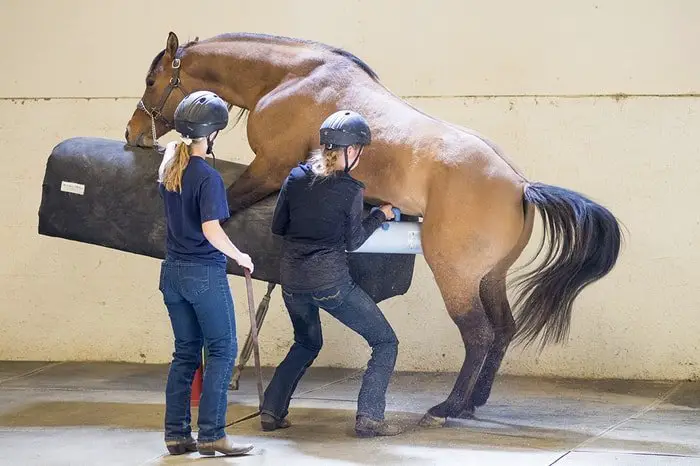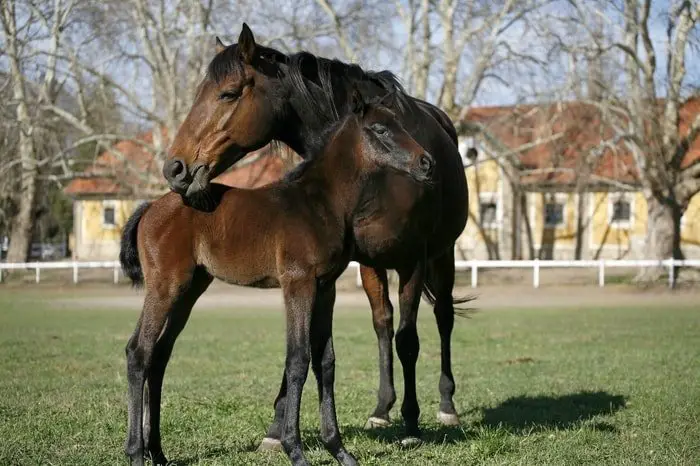Stallion becomes sire because of f reproductive capability. The stallions are selected based on performance, pedigree, and confirmation, and reproductive capability is last. The general lack of focus on fertility in the equine industry has resulted in a per cycle pregnancy rate of 45-55%. Seasonal pregnancy rates should be above 85% in the well-managed herds. Stallion infertility is one of the vital causes of poor pregnancy rates in mares.
Poor performance in a stallion is most often referred to as sub-fertility. It is generally applied to stallions who return less than 30% pregnancy rates in first cycle breeding and a 10-70% seasonal pregnancy rate. A stallion is considered infertile if he has a pregnancy rate of less than 10% for the season. Many reasons that a stallion becomes sub-fertile or infertile and quite a few of them are reversible.

Causes of Infertility in Stallion
The sterile male is readily identified, but males with reduced fertility pose a severe problem. The causes of infertility or sub-fertility in stallions may be broadly classified as:
1. Natural Causes: These include diseases, hormonal imbalance, physical abnormalities, injury or trauma, genetic disorders, and congenital abnormalities.
2. Artificial Causes: These include physiological problems, stallion mismanagement, therapeutic drugs, manual collection errors, and poor handling of frozen o cooled semen.
Natural Causes Infertility in Stallion
1. Equine Viral Arteritis (EVA)
Equine Viral Arteritis is transmitted or shed mainly via semen. The virus is localized in the stallion’s accessory seminal glands and may be shed in the semen for weeks afterward and possibly even live on the occurrence of infection. It isn’t easy to recognize clinical signs. However, the signs may include fever, depression, lethargy, runny nose, conjunctivitis, and swelling in the lower legs and reproductive organs. It is also a major cause of abortion in mares. Vaccination against EVA is available.

2. Contagious Equine Metritis (CEM)
CEM is a transmissible bacterial disease of horses. The bacteria responsible for the symptoms are Tayloreequigenitalis, Klebsiella pneumonia, or Pseudomonas aeroginosa, known as the most important. It is spread through direct contact at mating and the semen of infected stallions. Infected stallions are usually passive carriers, and infected mares may show vaginal discharge about a week after mating with a carrier stallion. Prevention is achieved by swabbing for the bacteria and treating them appropriately.
There are four different mutations of this infectious viral disease, and it is widespread in the equine population. Venereal disease is caused by EHV type- 3 and is also known as Equine Coital Exanthema or Genital Horse Pox. The clinical signs manifest 4-8 days after sexual contact and will be seen as small round lesions on and around the genitalia of both sexes. It is pretty painful, and the stallion will be reluctant to serve mare.
4. Urospermia
The presence of urine in the ejaculate. Contamination can be detected through color or smell but is often not detected until the sperm are microscopically examined. The causes are unknown, and the stallion shows no other signs of illness. If possible, collect the semen directly after urination.
5. Haemospermia
The presence of blood in the semen is not uncommon in stallion in heavy use. This can be by infection, excessive trauma to the urethral membrane, rupture or tear inside the penis, parasites, or even urinary bladder stones. It can be painful at erection, and treatment may involve prolonged sexual rest or antibiotics depending upon the underlying cause.
6. Penial Inflammation or Balanitis
Its causes can be bacterial, viral, due to parasitic infection, tumor growth, or the result of an injury. Stallion shows reluctance to breed due to pain. Specific treatment is needed in all cases but most often includes sexual rest and increased cleansing of the pe
7. Tumor or Neoplasia
The most common primary testicular cancer in stallions is seminoma. It is most often benign but can spread rapidly and can destroy much of the testicle. Other testicular tumors are Sertoli cell tumor, teratoma, Leydig cell tumor, embryonic carcinoma, and teratocarcinoma.
8. Varicocoele
Vascular dilatation may enlarge and interfere with typical counter-current heat exchange between the testicular artery and veins. They may cause by a verminous process, congenital or acquired. They may accompany tumors or mimic tumors.
9. Flaccid Penile Paralysis
This is common following chronic debilitation. It doesn’t resolve even after the horse refed and he gains weight.
10. Priapism
Priapism is a non-natural tumescence. The penis, in this case, is hard as a wooden baseball bat. Priapism occurs secondary to drug administration.
Hormonal Imbalances or Abnormalities
Stallions are seasonal breeders, and their hormone production and the resulting increase in sperm production are stimulated by light. It begins in the hypothalamus and pituitary. An increase in light produces GnRH, which stimulates the pituitary to secret FSH and LH. These gonadotropins then travel to testes, where they affect Sertoli cells and Leydig cells, respectively. A high estrogen level is essential in the stallion during breeding season as it binds testosterone, the essential hormone involved in the stallion’s libido.
A common reason for sub-fertility is the use of anabolic steroids. The brain recognizes the substances as a high level of testosterone and shuts down or slows the production of sperms. Long-term use will result in reduced testicular size and low sperm count.
Physical Abnormalities of Stallion infertility
1. Testicular Degeneration
This is the most common cause of sub-fertility and is a chronic condition that leads to infertility. The causes of testicular degeneration may be trauma or injury, nutritional, toxic, genetic, or idiopathic. It most commonly affects older stallions, and signs include:
- Increase in testicular size.
- Softening of the testicle.
- A decline in sperm quality and concentration.
2. Spermiostasis
This is generally an acquired condition where the stallion experiences intermittent or complete obstruction of one or both the ampulla. It is best described as abnormal retention of sperms within the duct system and is most often seen in the rested stallion.
3. Scrotal Abnormalities
Any abnormal conditions within the scrotum can cause infertility. Temperature regulation is essential in spermatogenesis, and any inflammation is detrimental to sperm.
4. Penile Abnormalities: Apart from the already described Balantitis, penile abnormalities are a relatively common cause of infertility.
5. Phimosis: The penis cannot protrude from the seath or prepuce. It is a severe problem and is most often a congenital disability.
6. Paraphimosis: The penis cannot retract in the prepuce and is most likely seen following trauma or other external insults.
7. Orchitis: Testicular inflation or orchitis caused by local trauma. In few cases, this may result in subsequent immune-mediated orchitis, which occurs when there is a breakdown of the blood-testicular barrier.
Genetic Disorders and Congenital disabilities
These include various defects involving the sperm, testicle, penis, and duct system.
1. Abnormal sperm: The first investigation on a physically normal sub-fertile or infertile will invariably be semen evaluation, and this may help investigate congenital and hereditary defects of sperm can be discovered.
2. Testicular Hypoplasia: It is a congenital disability in which the potential for the development of spermatogenic epithelium is lacking. One or both testis may be hypoplastic. The semen is watery and contains few or no spermatozoa in the sterile animal.
3. Cryptorchidism: In this one or both, the testis fails to descend from the abdominal cavity into the scrotum. It is a hereditary defect transmitted by the male; thus, animals with unilateral cryptorchism should not be used for breeding. Animals with unilateral conditions have normal fertility. However, those with bilateral conditions are sterile.
4. Segmental Aplasia of Wolffian Duct: In this defect, small or large segments of one or both Wolffian ducts are missing.
Artificial Causes of Infertility in Stallion
The artificial causes of stallion infertility are as follows:
1. Physiological Problems: The problems account for many infertility installations and usually arise because of how the stallion has been managed.
- Complete disinterest in mares.
- Inability to gain an erection.
- Inability to mount.
- Inability to thrust.
- Inability to ejaculate after repeated thrusting and mounting.
- Dismounting at the beginning of ejaculation.
- Inability mate with more than one mare every day or every two days.
2. Mismanagement of Stallions: Good mare and stallion management are crucial for maximizing breeding efficiency.
3. Use of Glucocorticoids or Anabolic Steroids: High percentage of deformed spermatozoa and low motility. This may be confused with poor abnormal fertility, poor sperm quality, or testicular degeneration.
4. Habronemiasis or Summer Sore in the Prepuce or Urethra: Habronemiasis is a parasitic skin condition caused by hatched larva of Habronema spp that results in hypersensitivity reaction. Flies are fond of moist areas such as the prepuce and urethral opening, where they lay their eggs. The larva invades the skin lesions formed progress rapidly and pyogranulomatous.
5. Unexplained Sub-fertility in Stallion: There are several causes of sub-fertility in the stallion, including genetic, nutritional, degenerative, hormonal, parasitic, infectious, thermal, radiation, immune, neoplastic, and idiopathic causes.
Concluding Remarks on Infertility in Stallion
The ultimate sign of infertility is failure to produce offspring. A subnormal number of offspring also constitute infertility. Until fertilization, both sexes’ responsibility for successful reproduction is shared, and after that, the female is responsible.